Monarchy of Cambodia facts for kids
Quick facts for kids King of Cambodia |
|
|---|---|

|
|
| Incumbent | |
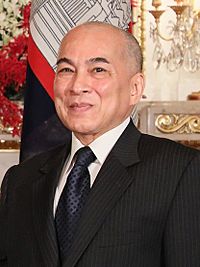 |
|
| Norodom Sihamoni since 29 October 2004 |
|
| Details | |
| Style | His Majesty |
| First monarch | Queen Soma |
| Formation | 50 CE; 1,975 years ago |
| Abolition | 18 March 1970 – 24 September 1993 |
| Residence |
|
| Appointer | Royal Council of the Throne |
The monarchy of Cambodia is the system where Cambodia is led by a king or queen. The King of Cambodia (Khmer: ព្រះមហាក្សត្រកម្ពុជា) is the country's head of state. The king is also the leader of the Royal House of Norodom.
Today, the king's power is mostly symbolic. This means the king represents the country but does not make daily government decisions. The monarchy has existed since at least 50 AD. It was stopped for a while between 1970 and 1993.
Since 1993, the King of Cambodia has been chosen by a special group. This makes Cambodia one of the few countries where the monarch is elected. The king is chosen for life by the Royal Council of the Throne. This council includes important political and religious leaders. Candidates must be male descendants of King Ang Duong and at least 30 years old. They come from two royal families: the House of Norodom and the House of Sisowath.
Contents
The King's Role
Cambodia's constitution, created in 1993, explains the king's duties. It states that the king "shall reign, but not govern." This means the king is a symbol of national unity and continuity.
The king performs many important duties for the country. These include:
- Choosing the prime minister and the Cabinet.
- Opening meetings for the two main law-making groups: the National Assembly and the Senate.
- Being the top commander of the Royal Cambodian Armed Forces.
- Leading the Supreme Council of the National Defense.
- Meeting with the prime minister twice a month to learn about state matters.
- Signing laws passed by the government.
- Acting as a "supreme arbiter" to help state groups work well together.
- Greeting ambassadors from other countries.
- Having the power to reduce or cancel punishments for crimes.
- Leading the Supreme Council of the Magistracy, which oversees judges.
- Appointing some members to state groups like the Senate.
- Giving out national awards.
The king also does other important things not listed in the constitution. For example, the king leads national events and religious ceremonies. The king supports good causes and represents Cambodia when visiting other countries. While there have been female rulers in the past, the 1993 constitution currently says women cannot become queen.
Royal Palace Ministry
The Ministry of the Royal Palace helps the king with his duties. It is currently led by Minister Kuy Sophal. The Supreme Privy Advisory Council also helps the king. This council is now led by former Prime Minister Hun Sen.
Ancient History of Kings
Cambodia has a very long history of kings and queens. The monarchy began around 50 AD. Early kingdoms like Funan and Chenla had many rulers. These rulers helped shape the early history of Cambodia.
The Khmer Empire (802–1431) was a very powerful time for Cambodia. During this period, many famous kings ruled. They built amazing temples, like those at Angkor Wat. This era was a golden age for the Khmer people.
Middle Period (1431–1863)
After the Khmer Empire, Cambodia entered a new period. Kings continued to rule from different capital cities, like Chaktomuk, Longvek, and Oudong. This time saw many changes and challenges for the kingdom.
Modern Kings (1863–present)
French Protectorate (1863–1953)
During this time, Cambodia was under the protection of France. The kings still ruled, but France had a lot of influence.
| Name | Portrait | House | Birth | Death | Relationship to predecessor |
|---|---|---|---|---|---|
| Norodom Prohmbarirak នរោត្ដម ព្រហ្មបរិរក្ស 11 August 1863 – 24 April 1904 |
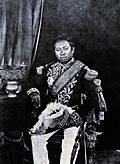 |
Norodom | 3 February 1834 Angkor Borei |
24 April 1904 Phnom Penh |
Son |
| Sisowath Chamchakrapong ស៊ីសុវត្ថិ ចមចក្រពង្ស 27 April 1904 – 9 August 1927 |
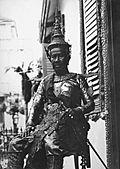 |
Sisowath | 7 September 1840 Mongkol Borey |
9 August 1927 Phnom Penh |
Half-brother |
| Sisowath Monivong ស៊ីសុវត្ថិ មុនីវង្ស 9 August 1927 – 23 April 1941 |
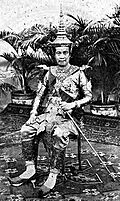 |
Sisowath | 27 December 1875 Phnom Penh |
23 April 1941 Kampot |
Son |
| Norodom Sihanouk នរោត្តម សីហនុ 24 April 1941 – 2 March 1955 |
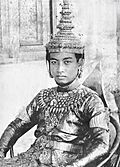 |
Norodom | 31 October 1922 Phnom Penh |
15 October 2012 Beijing |
Maternal grandson |
First Kingdom of Cambodia (1953–1970)
Cambodia gained full independence from France in 1953. The monarchy continued to lead the country.
| Name | Portrait | House | Birth | Death | Relationship to predecessor |
|---|---|---|---|---|---|
| King Norodom Suramarit នរោត្តម សុរាម្រិត 3 March 1955 – 3 April 1960 |
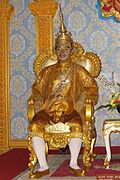 |
Norodom | 6 March 1896 Phnom Penh |
3 April 1960 Phnom Penh |
Father |
| Queen Sisowath Kossamak ស៊ីសុវត្ថិ កុសុមៈ 20 June 1960 – 9 October 1970 |
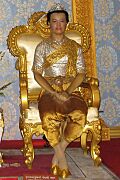 |
Sisowath (by birth) Norodom (by marriage) |
9 April 1904 Phnom Penh |
27 April 1975 Beijing |
Consort |
Second Kingdom of Cambodia (1993–present)
The monarchy was restored in 1993 after a period without a king.
| Name | Portrait | House | Birth | Death | Relationship to predecessor |
|---|---|---|---|---|---|
| Norodom Sihanouk នរោត្តម សីហនុ 24 September 1993 – 7 October 2004 |
 |
Norodom | 31 October 1922 Phnom Penh |
15 October 2012 Beijing |
Son |
| Norodom Sihamoni នរោត្តម សីហមុនី 14 October 2004 – present |
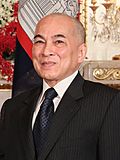 |
Norodom | 14 May 1953 Phnom Penh |
Living | Son |
Royal Symbols
See also
- Family tree of Cambodian monarchs
- List of heads of state of Cambodia
- Prime Minister of Cambodia
- List of prime ministers of Cambodia
- Devaraja
- Abolition of monarchy




